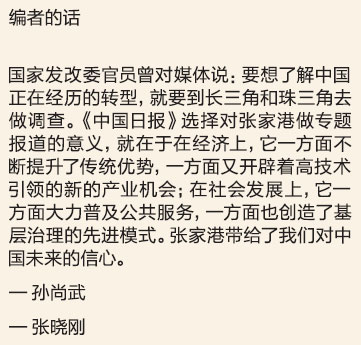From the editor


Why Zhangjiagang? It's only a small city (well, small by Chinese standards) in the Yangtze River Delta, with a population of 1.6 million. What does the city have that it can claim to represent the ongoing transition of an enormous country like China?
Well, it does have a lot of things to impress us in this regard. China Daily is featuring it as a window of the country's changes for a good reason. In fact, officials from the National Development and Reform Commission often tell journalists: Want to learn about how China's transition is actually taking place? Go to the Yangtze River and Pearl River deltas.
After the city's GDP rose to be equivalent to that of a province in China's western frontier region (say Qinghai province), both its government and the business community have been working together to make new progress in both social and economic development.
They insist they can. In the early months of 2015, as the world was talking about the so-called China slowdown, Zhangjiagang showed us, and the rest of the world, what a trailblazer of the Chinese transition could do.
What we see in Zhangjiagang is an economy that, while keeping up its traditional strengths, is quickly opening up new, more technology-driven frontiers and a society that highlights both public education and its citizens' self-management. Indeed, things going on in the city and its nearby village communities have brought us confidence in China's future. That's why we chose Zhangjiagang.
- Sun Shangwu
- Ed Zhang

(China Daily European Weekly 10/22/2015 page2)
Today's Top News
- Japan tempting fate if it interferes in the situation of Taiwan Strait
- Stable trade ties benefit China, US
- Experts advocate increasing scope of BRI to include soft power sectors
- New engine powers cargo drone expansion
- China to boost green industry cooperation
- Manufacturing PMI rises in November






























